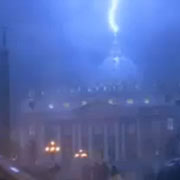When someone tells me “I pray better out in nature,” I take them seriously. That’s not a license to skip mass and observe the sabbath with a Sunday afternoon bush walk, but experiencing the beauty of God’s creation is very conducive to prayer.
I was reminded of that yesterday, when I caught up with an old friend (and newly ordained priest) at Cape Bridgewater. We recited the psalms in competition with the roar of the ocean, and I gazed at a pristine seascape in the intermittent prayer of silence.
This picture doesn’t capture it, but we were highly elevated and totally isolated:

True story: Cape Bridgewater has the highest coastal cliffs in Victoria,
and the beach house behind us was the only building for kilometres around.
The trip wasn’t all psalms and canticles. Evening Prayer divided an afternoon of coffee from a night of beer and Chinese. (The food, not the language.) But the prayer was a highlight, and will become an enduring memory of my first visit to a stunning corner of Victoria.
This is why churches should be beautiful. Beauty helps us to pray. Can’t we all relate to these words from Pope Benedict on religious art?
But there are artistic expressions that are true roads to God, the supreme Beauty — indeed, they are a help [to us] in growing in our relationship with him in prayer. We are referring to works of art that are born of faith, and that express the faith. We see an example of this whenever we visit a Gothic cathedral: We are ravished by the vertical lines that reach heavenward and draw our gaze and our spirit upward, while at the same time, we feel small and yet yearn to be filled…
The parish priest of St Mary’s West Melbourne says much the same in this short video on his church’s restoration, but he adds something important. Beautiful churches evoke the beauty of nature. Artistic and architectural beauty “is in some way an imitation” of the work of God, the Divine Artist.





Dear Father,
It seems that neither your heart nor Father Michael’s is restless. Were you reading the psalms of that day’s Office or something else, such as the Gradual or Passion psalms.
Best,
Anthony
Yes, it was “just” Vespers of the day.
Fr Michael prefers to pray the simple intercessory prayers at the back of the breviary in place of the embellished (and often badly translated) intercessory prayers in the psalter. I’m not so familiar with those prayers, and I screwed up my nose at an especially trite prayer for sunshine. I was thinking of the farmers! Unbeknownst to me, the prayer immediately following is a petition for rain. But Michael thought it best to skip that one after my disruptive reaction to the first!
Fr John – That is a neat picture of you.
I think Fr Michael’s brother took it with his phone. I didn’t even know he was there! I hope he didn’t hear our woeful chanting of the Magnificat. Ha ha.
Fr John – I am very sure that you and Fr Michael must have surely had very close contact with The Almighty. I sometimes take a twig, a leaf or a flower and I keep gazing at it as I pray. I then come into His presence and God speaks to me. Looking at nature or being in its presence is really awesome – We are brought into close contact with the Almighty God.